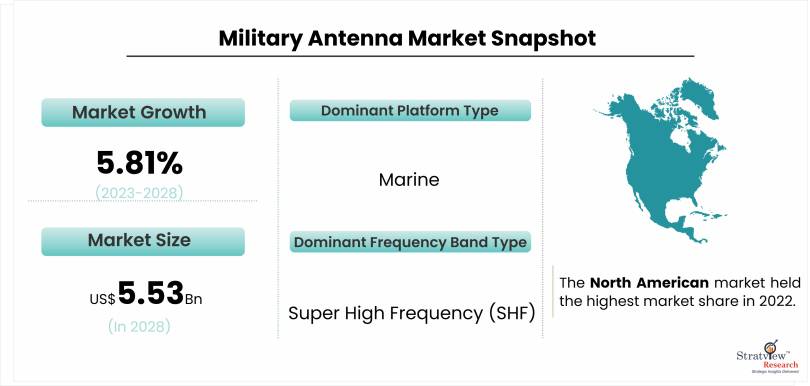Military antennas are essential for communication, intelligence, surveillance, and reconnaissance (ISR), and command and control in the defense industry. Developing countries are increasingly investing in military antennas to modernize their armed forces and improve their defense capabilities. The military antenna market is estimated to grow from US$ 3.93 Billion in 2022 to US$ 5.53 Billion by 2028 at a CAGR of 5.81% during the forecast period.
There are a number of factors driving the growing demand for military antennas in developing countries, including:
- Increased defense spending: Developing countries are increasing their defense spending to meet the growing security challenges they face. This increased spending is being used to modernize military equipment, including antennas.
- Rising military modernization programs: Many developing countries are engaged in military modernization programs to upgrade their armed forces and make them more capable. Military antennas are a key part of these modernization programs.
- Growing border disputes and regional conflicts: Developing countries are increasingly involved in border disputes and regional conflicts. This is driving the demand for military antennas to improve communication, ISR, and command and control capabilities in combat zones.
- Increasing terrorist activities: Developing countries are also facing an increasing threat from terrorism. This is driving the demand for military antennas to improve surveillance and security capabilities.
Key trends in the military antenna market in developing countries
Some of the key trends in the military antenna market in developing countries include:
- Growing demand for 5G-compatible antennas: As developing countries adopt 5G technology, the demand for 5G-compatible military antennas is expected to grow significantly.
- Increasing adoption of AI-powered antennas: AI-powered antennas offer a number of advantages for military applications, including improved performance, security, and adaptability. As a result, the adoption of AI-powered antennas is expected to increase in developing countries in the coming years.
- Growing demand for lightweight and low-SWaP antennas: Mobile and airborne military applications are driving the demand for lightweight and low-SWaP antennas in developing countries.
- Increasing demand for metamaterial-based antennas: Metamaterial-based antennas offer unique performance characteristics that are ideal for a variety of military applications. As a result, the demand for metamaterial-based antennas is expected to grow in developing countries in the coming years.
Key challenges in the military antenna market in developing countries
Some of the key challenges in the military antenna market in developing countries include:
- Budget constraints: Many developing countries have limited defense budgets. This can make it difficult for them to afford the latest and most advanced military antennas.
- Lack of technical expertise: Some developing countries lack the technical expertise to develop and manufacture their own military antennas. This can lead to a reliance on imports, which can be expensive and time-consuming.
- Counterfeit products: There is a growing problem of counterfeit military antennas in developing countries. These counterfeit products are often of poor quality and can fail in critical situations.
Conclusion
The demand for military antennas in developing countries is expected to grow significantly in the coming years, driven by a number of factors, including increased defense spending, rising military modernization programs, growing border disputes and regional conflicts, and increasing terrorist activities. However, developing countries face a number of challenges in meeting this demand, including budget constraints, lack of technical expertise, and counterfeit products.
Key players in the military antenna market in developing countries
Some of the key players in the military antenna market in developing countries include:
- Bharat Electronics Limited (India)
- Hindustan Aeronautics Limited (India)
- Rafael Advanced Defense Systems Ltd. (Israel)
- Elbit Systems Ltd. (Israel)
- Aselsan Elektronik Sanayi ve Ticaret A.Ş. (Turkey)
- C4I Systems Co., Ltd. (South Korea)
- Hanwha Systems Co., Ltd. (South Korea)
- LIG Nex1 Co., Ltd. (South Korea)
- China Electronics Technology Group Corporation (China)
- Huawei Technologies Co., Ltd. (China)
- ZTE Corporation (China)
These companies are developing and manufacturing a wide range of military antennas for a variety of applications, including communication, ISR, and command and control.
Future outlook
The future of the military antenna market in developing countries is very promising. The growing demand for military antennas, coupled with the increasing investment in defense by developing countries, is expected to drive significant market growth in the coming years. The key players in the market are well-positioned to meet this demand





Comments